What makes us visit galleries and museums? Is it the very personal pleasurable gain through enjoying the artworks, or is it the social recognition that we try to obtain by taking and posting selfies in the cultural context online? On International Museum Day, when many world museums and galleries open their doors to the public for free, thousands of people rush through the exhibitions with cameras memorizing their encounters with the art. There is no time to take a better look, breathe in, and reflect!
In Jakarta, Indonesia, I have even witnessed visitors walking through the galleries with their mobile phones recording the whole experience of looking around. Is it reporting live on Facebook/Instagram/Snapchat? Or is that postponing the pleasure for later viewing? Do we not have time to stop and enjoy the art? Why do we have time to stop in front of the painting and pose for selfies? Why do we have time to retake the photograph, in case our firstly shot facial expression didn’t turn out the way we wanted? Does this kind of behavior raise our social profile of supposed art lovers or art connoisseurs?
You might think this proof of our tragic sadness ends here. But what I witnessed at the Galeri Nasional Indonesia, on the day when museums should be celebrated, was a true escalation of art raping for the sake of our egoistic need for public attention. Even if this surely is not a single example, I was genuinely shocked.
Hunger for likes
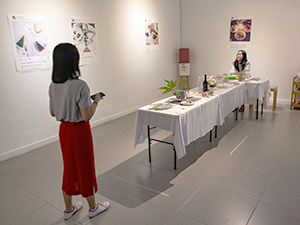
Evelyn Huang and Shila Ghaisani have curated 15 young Jakarta artists who have previously participated at EXI(S)T, the mentoring program affirming their presence in the Indonesian art landscape, by showcasing their latest works under the umbrella theme of “Tomorrow As We Know It”. Fransisca Retno was one of these perspective artistic forces; at Galeri Nasional Indonesia she exhibited a very self-explanatory work. The table was set, as for some dinner, with a flower arrangement and a bottle of wine. Yet, on the plates – Instagram photos of the food were served. How do you like your dinner? Actually, the dinner with the Instagram menu can only be loved, not liked; this social network recognizes and counts only hearts! On the walls of the gallery, more Instagram photos with numbered hearts decorated the dining room.
Fransisca Retno literally served Instagram likes as dinner, and this clueless visitor greedily jumped on the hook
The two young girls visiting the gallery on the free-visits day understood they were invited to join this dinner. Even if there was only a chair at the head of the table, even if there were “do not cross” demarcation lines on the floor, one of these two girls decided to, literally, cross the line. She concluded that the chair is meant for her to sit on, and take selfies. So she sat and posed like that in front of her friend’s camera. For probably the same heart-shaped signs of appreciation that Fransisca Retno has served as the main course.
Selfies in interaction with the art
I know, interaction with the art might be the response the artist could have only hoped for. However, there is something substantially wrong when one decides to appropriate decision about the interaction, without the consent or invitation of the author. These two young art-in-social-media lovers entered the next room and lowered the bar of politeness even more.
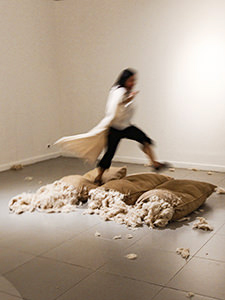
Ratu R. Saraswati‘s work was named “I Beg I Promise”. The durational performance in which the artist wanted to translate the feeling of burden, self-punishment, helplessness, and hope, left on the floor of the gallery three jute sacks, shredded kapok, and a dress on a hanger. The interactive girl picked up the hanger with the dress as if being in a self-service supermarket. She took off, running over the jute sacks, trying to get the dress to fly as if it was a kite, while her camera-operating friend was shooting the scene. They repeated the jogging over the artwork several times so that they could choose the best moment later. They were not even slightly disturbed by the presence of my clicking camera. I guess they were thinking “The more, the merrier”? One could never overdo internet fame?
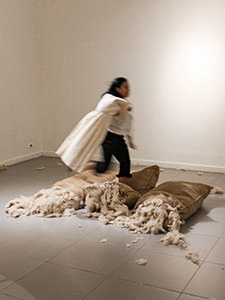
Selfies out of control
To appreciate the art, one needs to look at it from an appropriate distance. Entering the artwork’s space doesn’t allow us to perceive the context. And the context in which these two girls readily jumped in was very clear. The artist even wrote it on the wall if they would have wanted to read it: our beliefs in the existence of sin, guilt, and shame affect our seeing of the self-image. Those feelings can influence our ability to stop actions that are contrary to moral and civilized, explained Saraswati.
The thing is that our selfies-driven interaction with the art that never asked us for such a response doesn’t only make us look stupid. It actually confirms we are. Otherwise, we would do the wrong thing and hide the evidence, and not promote it on social media.
Lines should not be crossed
Monica Hapsari‘s work “Antara” was also provoking the interaction (when using the word ‘provoke’, we should immediately remind ourselves of the rapists defending their actions with arguments of how the raped girl dressed provocatively). The big black sphere was rotating on the top of the pyramid, placed in the corner of the room. The rectangular carpet of sand was covering the floor, with concentrating circles drawn in the sand. Probably the first visitor’s foot that crossed the line invited others to follow in his/her footsteps. The sand rings were now only looming. The interactive girl stepped courageously from sandless to a sandfull area, put her sunglasses on, sat down, and posed as if she was on the beach.
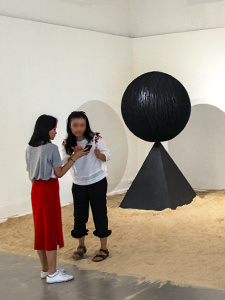
We can witness this kind of brainless behavior invading many world museums and galleries, or cultural spaces in general. Art is becoming merely a decorative background of the truly remarkable content: our own image. If we didn’t record ourselves, our selfies, in front of the “Mona Lisa”, it is as if we have never been in front of it! Likes and loves and pins prove our existence; they comfort our experiences. Without our selfies, we are not ourselves.
Selfies in the shadow of small and busy personnel
I was curious about Galeri Nasional’s intentions for this exhibition – was I missing something? These were clearly not the only visitors crossing the lines of artwork and good manners. The only official person working in this part of the complex was a young man at the entrance who was making sure that all visitors leave their bags there.
“No, it is not allowed to touch those artworks“, he answered my question and added: “I think.” The instructions on how to treat the art are not clear even to the gallery’s employees! “There had to be another colleague of mine here, but he couldn’t come today…”, the young man started to apologize, as if I was trying to find the guilty person. I stopped his excuse delivering and explained how I only wish to understand the gallery’s policy, which results in the actions I find shocking.
What is the purpose of NOT being allowed to take your bag in the gallery? If on the other hand, you can walk over the artwork, jump on it, dance with it, handle it in any way you can think of?
Counterproductive restrictions of the old age
Obviously, many galleries have completely outdated restrictions. I am telling you: what is the purpose of NOT being allowed to take your bag inside? If on the other hand, you can walk over the artwork, jump on it, dance with it, handle it in any way you can think of? The dress from Saraswati’s work you could even put on and leave the gallery dressed in the art piece! But bags are being demonized?! What is the purpose of the restriction for not using flash photography in the gallery, if all other kinds of photography are allowed?!
It seems to me as if the restrictions we blindly follow were once printed on the entrance doors of our institutions, and now we actually believe that bringing a bag, French fries, or an ice cream inside the gallery is the most probable way of making the damage. Damage is always the product of unavoidable circumstances or human behavior. This means we should be applying common sense, and instead of requesting our rare personnel to guard the visitors’ bags, relocate them to sit in the galleries and secure the artworks from ever-growing social media aggression, led by selfies.
Flood in the shadow of the selfies
Finally, I would like to add that it was I who first noticed the big puddle of water in between the artworks on the first floor and informed the staff. The broken air conditioning system created the little lake two meters wide, without any personnel noticing it. I guess they were all occupied by protecting the artworks from the dangerous attacks of bags and purses.
If you are interested in the follow-up on this story, read Picking the Easy Target: #Instabullies Raping the Selfie Girl. In an exclusive statement to Pipeaway, Selfie Girl apologizes for her behavior.

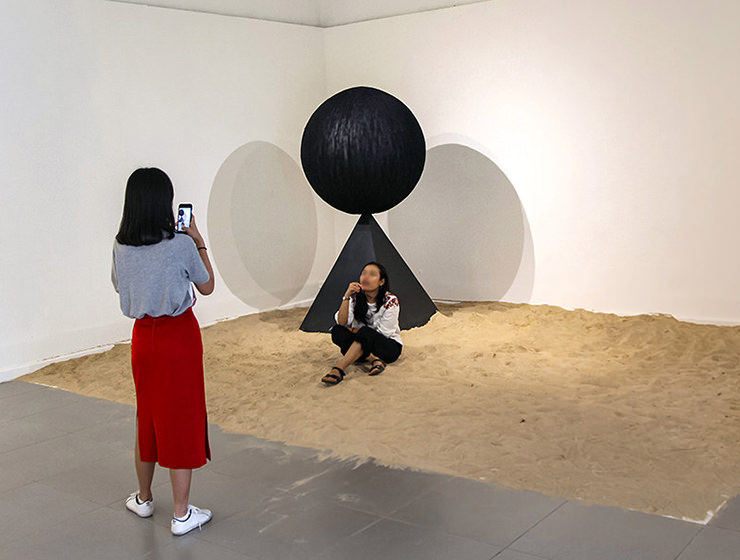

i know right, visiting artspace is not supposed to be because of other purpose. Not for taking photographs for those who see the beauty of photos and what’s in its surroundings, not for looking around searching for topics to write on the blog for those who see the beauty of writings. Its supposed to be for the art, right? agree. And such things as this blog post wouldn’t be here if the purpose were taken seriously. or am i wrong? or my eyes and mind sees different kind of beauty?
I am sorry, not sure if I fully comprehended your point of view.
Yes, sure, we should all speak/write/communicate about art. The more, the merrier. I have written about arts many times, and will.
But not writing about how galleries badly organize their exhibitions will certainly not motivate them to improve. It is certainly gallery’s responsibility to organize the exhibition of works in a professional way.
So for me, there is only one answer: always write. It is the journalist’s job, AND responsibility to write.
It would be irresponsible NOT to write about it.
It would be almost as irresponsible as joining these two and jump on the art exhibits like they are toys, and gallery – kindergarten.
You see, if I would have visited a kindergarten, I would have certainly not written about the kids tearing apart the pillow and enjoying themselves.
But this was not the article about the kindergarten.
Good article. Nice angle of view.
Thank you for your compliment!
Hi Ivan, this is thoroughly interesting observation. I’m a museum professional and briefly worked at an art museum in Jakarta myself, and have observed similar behaviour. As much as I am appalled by the behaviours you observed and wrote about, here is one possibility why these two young ladies were behaving the way they did: it was never the culture in Southeast Asia (or perhaps even the entire Asia continent) to practice museum-going as an activity. As a result, it’s not uncommon to find “unfitting” behaviours in galleries and museums across Indonesia and the region. Let’s not even start with the added layer of technology & social media.
By no means am I excusing careless, reckless, entitled behaviours as you observed. I am first and foremost an art advocate and educator. However, just as a child has to be taught to read and write by someone who knows how to do these things, museums cannot assume their visitors would know how to behave (and what to do/ not to do, what to observe, what to learn, etc.) if the front desk, gallery guards or guides, and other staff members cannot even communicate this message clearly and show by example (I have seen gallery guards texting or making phone calls out in the open.) It always takes a whole team to show how a space should be utilized before visitors can consider following in those footsteps.
To track back a little, the concept of museum came from (West) Europe, and it could very well be that this traditional concept of the museum (visual stimulation, passive learning, no other methods of interaction) does not fit with cultures and societies in Asia. This is actually something within Museology that I’ve been thinking about.
I’d be more than happy to discuss more about museum practices with you, if you’re interested. Thank you for your observation, article, and point of view. It’s a great food for thought for me this morning.
Hi, Clara!
Thank you for your thorough and thoughtful insight!
I understand your point that museum-going activity is something that was not a part of the culture in this region.
To be fair, my intention was never to label entire geographic areas as ignorant. With this article, I wanted to question the professional level this particular exhibition at National Gallery of Indonesia was organized, which consequently allowed excesses like these to happen. I am aware these examples are happening EVERYWHERE around the world, so we could always find different explanations or justifications for what is basically – a lack of professionalism of the most responsible ones in the chain (organizers of the exhibition).
Indeed, I could have approached the girls in question, and ask them what were they doing, or point out how wrong it was. But my Westerner’s mind immediately assumed that it was me who was wrong. That I have probably not read the instructions about the interactivity of the exhibits. So I approached the only member of staff available – the young man guarding the visitors’ purses and bags at the gallery entrance. Only after he has confirmed that the particular exhibits were NOT interactive, I understood that the museum underestimated the problems you are clearly identifying.
That is why I actually conclude with the need that museums should approach the problems happening at their exhibitions proactively. Without gallery guards, it is possible that the big puddle of water from the leaking air conditioning system appears in the middle of the gallery without anyone noticing (And it was ‘leaking’ drop by drop! So HOURS have passed and during this time the problem was not observed by the officials!). If they cannot observe the possible damage that can happen to the artwork by hours-long dripping of their own water, how could they even notice the behavior of the visitors happening in the instant second? Without noticing it, it is not possible to correct it either.
Thank you for your proposition to discuss more about museum practices. This is not my special area of expertise, but surely, if you think I can add anything valuable to the discussion, I would be happy to join it and learn something new from the field professionals such as yourself.
Dear Ivan,
Im sorry to hear about your experience. I was also a visitor and I appreciate all artworks and enjoyed it. I did found lots of visitors taking pictures for the sake of themselves in it.
Believe me, when I read your article, I felt the irony with society these days. However, not all visitors behave the same way. I fully respect all artworks.
Its true that most have faults intentions during their visits, however, that is also one of the ways to attract more people to visit the place (whether or not the intention is wrong ). For now, not so many realized the irony of taking selfies with a story that they dont even understand. Yes it tragic, yes I am embarrased too, but atleast MORE people will start to come to the events held by the creative industries in Jakarta… and thats a start.. I guess.. I hope..
Dear Levina!
Sure thing, not all visitors behave the same way. Thankfully.
The visitors come with different backgrounds, education, knowledge, life experiences, social status, needs…
I truly believe in democracy and don’t think that the arts should be reserved only for the “noble ones”.
Art is there for everyone to experience it. Different kinds of art are appropriate for different kinds of audiences.
The museum/gallery has to envisage them all. Museums/galleries are organizers with experience. What I or you can notice in 1-hour visit, they have been observing it for days, months and years. Their pool of knowledge should be so much wider.
In that sense, yes, I think it their responsibility to educate the audience clearly about the arts they will experience.
To provide guidance, tools on how to “read” the art, understand it, and appreciate it in much wider sense than its purely decorative aesthetics of the selfie’s background. If needed, to provide clear barriers between the artwork and the viewer.
This particular museum “protects” the modern art with 3-dimensional rope-fence, while this contemporary art is “guarded” by almost invisible white tape on the floor (even the post office will use the yellow tape as the marker of discretion!). So obviously there is no coherent approach to the issue, nor there are visible signs “do not touch the art” in this particular gallery. If the gallery guards are so expensive to have, I believe one printer will not kill the museum’s budget.
I agree that exposure on social networks can develop new audiences.
Especially as these networks are often targeting young audiences. And if the educational institutions did not focus on growing the pupils’ cultural potential, museums and galleries just need to deal with it.
Using social media exposure is not in the clash with the problems addressed. On the contrary, I think modern age tools COULD be the key to reach these audiences, and use their interest in public exposure and sharing content for promotion of the institution. But this does not mean that we should agree that the artist’s work has to be sacrificed for the “greater good”. No good is there if the visitors come to the gallery, and destroy the art piece. No good is there if we just motivate him/her to return and repeat the controversial action. We should want the visitors to grow with the artistic food we provide them.
yup additional security , or at least person in charge for the arts could be more helpful securing all that
Hear, hear!
You literally translate my thoughts ! Thank you for being outspoken to enough to highlight commonly ignored problem.
Thank you! It is true that speaking about problems is the most natural way to fight the ignorance.
We actually forced the guests to follow art gallery ettiquete in our gallery in Bandung. We hate to do this but we dont want any of our gallery visitor got hurt since most of our work are made of sharp metals and on the other hand we dont want our collections got broken. We also have gallery sitters that walk around to check but we still had unfortunate event as well. A peace of artwork made of soap(if im not mistaken) was broken in half coz some visitor sits on it just to take pictures. For about 17years we open our gallery for free for visitor to learn on how to visit a gallery since its uncommon for Indonesian to visit galleries or museums
I wonder how big is your gallery and how many gallery sitters do you have?
At National Gallery of Indonesia, I might have seen one in total. Maybe it was a lunch break.
Couldn’t agree more. I mean, disrespecting art is definitely not a culture here, but the thing is; art museum/galleries are more accessible nowadays, so it’s easier for all kinds of people to visit. Yes, people lacking of respect are included. They’re seeking acceptance and validation by the amount of likes on their Instagram page, trying to be relevant by sharing pictures of themselves “disgracing” the piece, touching them and even worse, using them as a prop. Sometimes, I found some posts, showing them using the artwork with a degrading caption too. It sickens me. They think sculptures are just sculptures that you can always “re-make” again. They’re just being disrespectful toward the artists and I’m confused how no one ever approach them and warn them. They thought they were being appreciative. They want people to see them as “cultured” and “artistic”, but instead, they look illiterate. I understand that art is not everyone’s cup of tea, but respect is always an option. They should learn to be more considerate and again, RESPECTFUL.
Thank you for your insight! It is so true that the respect towards other people and their property we learn at home. We don’t have to be big art connoisseurs to respect things that are not ours.
I guess the tricky thing is that the galleries are spaces which bring us to some other realities. And maybe “we” start to believe that old reality’s rules do not apply anymore and that we can join the playful ride where no damage can ever happen, because – the experience is so fantastic (read: not real)?
This is so devastating.
I suppose the problem is that the initial purposes to having these regulations have been forgotten and to be honest might not exactly relevant to these times anymore.
Again, the art cannot be overregulated, as too many rules have negative effects on the creativity. But true, if the exhibit is interactive, clear instructions could be more helpful instead of just banning entering with a bag into the gallery.
“selfies as declaration of stupidity: #instaidiots raping art galleries.” By Ivan Kraj. I just read this painfully but true article from @pipeaway.project that breaks my heart. For some of you guys know, when it comes to this topic i am very serious and i can be very mad about this. This article is just a smidge of example the horror of “raping art galleries” and yes I know we as indonesians never really have a “proper” education on how to appreciate art but even there is rules and regulations as big as a billboard there are still some people that stupid enough not to read that.
Theres this one time my mom approach this couple who was taking selfies and use the artwork as the background and they were crossing the line. My mom said that they can’t do that cause it has a very high chance of ruining the artwork (because it was made out of clay or some fragile medium) and then the girl said, and i quote “kenapa ga boleh? Yang lain boleh!” BOOM and it made me realize it just a matter of popularity and exsistensy.
I know (a lot) of people that took pictures in galleries and use the artwork as the background and to beautify themselves. Yes beautify themselves and not the artwork. By having a “good” background automatically it beautifies the picture and the person in it. “What is art if we are not a part of it? One should always check if the selfie turned out fine, and do it again and again until the artworks shines perfectly next to one’s face.” Funny story, i went to a very hype exhibition and in a very hip Artspace. It was Natisa Jones exhibition in Ruci. That day i choose to have a relaxing day by enjoying her artwork. But then i got bothered by these 2 girls. They kept taking pictures for like 3 minutes Infront of the artwork that i want to enjoy, i was kinda bothered so i approach them and said that i wanted to enjoy the artwork and then they said “bentar ya mba” and i just can’t take it anymore i was pissed so i just try to enjoy the other artworks and when i came back (i go around for like 5 minutes) and they are still there.
CONCLUSION IN THE COMMENT SECTION
My conclusion is, Indonesians need to be more educated about art and how to appreciate it and IF they already know the rules and regulations please please pleeeaaseeeeee do what it said. Don’t just think about yourself when you enter a gallery/exhibition. Please think about the artist and other visitors too. You don’t have to praise the artist to appreciate them, by just following the rules and appreciating the artwork we will be very thankful.
Thank you for your thoughts!
Just wondering, what are those reactions quoted in Indonesian? Are they curses? 🙂
To be honest, I must agree with almost anything you said. The purpose of those brainless millennials are obvious; to get a good photo for their instagram.
And it is somehow annoying, as a “self-claimed” art enthusiast to see people not appreciating art by ruining them. I also pitied people who are clueless; that each artwork has a story to tell but they just simply ignore it.
However, I must disagree on one note you said. On Monica Hapsari’s work, it is clear that there is a written instruction on the floor that said we are invited to sit on the sand. I came there and experienced the art myself.
And maybe, because of that instruction, people assume that the rest are the same.
Maybe, it would be nice if the exhibition itself makes it clearer that there is a line that should not be cross.
And just to educate those hunger-for-likes kids, to appreciate the real meaning of art.
I agree, maybe this instruction for Hapsari’s work produced more confusion about the other works that did not have such instruction.
On the other hand, Hapsari’s invitation was meant as an instruction on how to consume her artwork – by sitting in the sand and watching the big black ball turning around. The instruction on how to consume the artwork does not make the artwork an instant photo studio for selfie shots. These girls did not sit there for a second to look at the artwork. They sat down to look into their photo camera.
Da, dobro dosli u Indoneziji. People are so mannerless here and truly agonizing to see these kind of unrespectful things they did.
But I guess, thats the problem in Indonesia’s middle class people; that their mind is somehow melded into social media so bad, that their self aggrandizement is something more important than others property. That is not a justification, but Indonesians are lacking the needs to show their ego and love being in the spotlight. Even maybe I’ve been doing that kind of action, or maybe readers also have been in that kind of situation. Your article here really is insightful and can truly change a lot of Indonesian egoistic point of view and encourage more to respect art.
Hvala puno za misljenje, odlican je. Pozdrav iz Indonezija!
Thank you for your comment!
I don’t think this problem is uniquely Indonesian.
It is happening everywhere in the world, where social status can be strengthened by projecting images of our greater selves online, in the context that flatters us. Everybody does it. I can even admit I do it myself sometimes. It is that fragile borderline when our behavior becomes clueless, we should learn to recognize it and become more aware of ourselves and our actions, and how they effect our surrounding/context.
Those brainless people who think art is photography object–who think their skill of photography is good and think they can turn into model super instantly.
I understand the source of your anger, but for me the fact that galleries are giving away their space as photo shooting studio for free, is more disturbing.
Visitors can always be clueless, but galleries take responsibilities for the artworks they exhibit, so should know better how to protect them.
CMIIW, but Monica Hapsari’s “Antara” is indeed encouraging people to step & interact with it. In Indonesia, respecting artwork & museum going is never a culture. Well, the least I can do is to scold people who caught touching art work at galleries/museums. I’ve done it several times and after reading this article, I am more sure what I’ve done is right.
True, as an answer to one of the previous comments, it is possible that Hapsari’s instruction and lack of instruction for other artworks produced confusion when a visitor asks himself how should he consume the artwork. For sure, Hapsari’s encouragement was all about saying how the artwork can be consumed, and not about how the artwork can be the backdrop for creating our own “artwork”.
This my friend when you take something too far. You wont even care to standard thing. Too much Selfies to me is not an activity anymore. it acts more like as a mental handicap. Which directing toward stupidity.
Taking Thing Too Far
oh yeah, i’m not an art lover though.
Selfies are a social phenomenon, like so many others. They are a part of the construction of our public self.
They are the legitimate tool for promoting ourselves, in the light we choose.
But they cannot be a legitimate excuse for taking the artwork of others in our hands (without the artist’s permit) and use it in which ever way we want.
This essay speaks volume of our current generation. The same experience has happened to me and my fellow artists. Once a visitor wanted a photo of herself admiring the work, for composition sake, she stood so close to the work. She was practically off viewing distance.
Interesting example. Maybe she was really a fan of textures.
Fæking disgusting. I really loathe people like these who doesn’t care the art at all. This however, linked to the low education level that the country has.
It’s really sad to see people who doesn’t appreciate art do what they want inside an exhibition or a museum. I mean, at least they should have the decency not to obstruct the objects.
It is hard to understand internal motives of these girls. Personally, I think they just got “carried away”.
The problem is that the system has allowed it / supported it, by not providing written, physical and personal protection for the artworks displayed.
Organizers’ ignorance is more frightening in the long run than the one expressed by some visitors.
Aliens, I’m sorry for humanity.